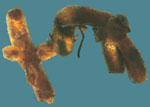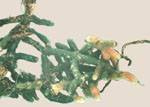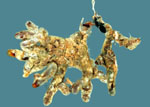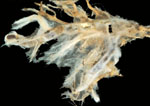 unknown
fungus
unknown
fungus
Exudates and hyphae of EMF form a major link between above-ground producers and soil food webs, providing carbon for a wide range of bacteria, protozoa, arthropods and microfungi. Mycorrhizal fungi are also important in above?ground food webs. EMF, with few exceptions, produce macroscopic sporocarps (mushrooms and truffles) that are important in the diets of animals, especially small mammals. Some rodents such as the California red-backed vole (Clethrionomys californicus) and northern flying squirrels (Glaucomys sabrinus) rely on these sporocarps for over 90% of their food supply and are primary prey for species such as the Northern Spotted Owl.
Click on thumbnail to load enLARGEment. Last modified January 16, 2001.
D6 Truncocolumella
citrina on Pseudotsuga menziesii
Truncocolumella
citrina on Pseudotsuga menziesii
E2 Lactarius
rubrilacteus on Pseudotsuga menziesii
Lactarius
rubrilacteus on Pseudotsuga menziesii
F8 Leucogaster
rubescens on Pseudotsuga menziesii
Leucogaster
rubescens on Pseudotsuga menziesii
I6 Hysterangium
sp.
on Lithocarpus densiflorus
Hysterangium
sp.
on Lithocarpus densiflorus